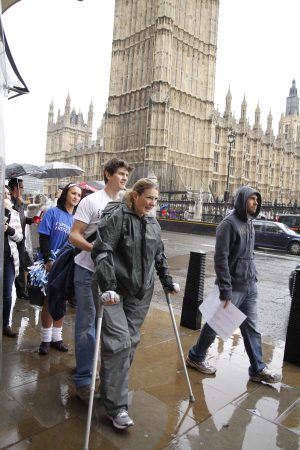
bi·on·ic - adjective
1: of or relating to bionics
2: having normal biological capability or performance enhanced by or as if by electronic or electromechanical devices
Though it may be described by its creators, Argo Medical Technologies, as a "wearable, motorized exoskeleton suit," it's no exaggeration to describe ReWalk as bionic technology—at least not according to Merriam-Webster's definition.
Back in April and May of this year, Claire Lomas used ReWalk to complete the London Marathon in 16 days despite being paralyzed from the chest down. This month, she is taking ReWalk home for daily use, which is something of a milestone in assistive technology. It's claimed that this is first time an exoskeleton suit has been used unsupervised in the home environment as a long-term alternative to the wheelchair.
Lomas suffered a T4 spinal cord injury (in addition to a broken neck, broken ribs and a punctured lung) following an equestrian accident in 2007. Of the 12 thoracic vertebra, T4 is the fourth from the top, located on the nipple line. Lomas' injuries left her unable to walk, apparently fated to spend the rest of her life confined to a wheelchair.

But having discovered the ReWalk through online research, Lomas was able to raise the money needed to buy a set: £43,000 (or $69,000). Crucial to the suitability of the ReWalk to her case is the fact that she retains the ability to use her arms, shoulders and hands: crutches are essential for stability.
Walking with ReWalk is by no means effortless—Lomas could only walk a few steps at the very beginning—but it does entirely take over movement of the legs. ReWalk is essentially a wearable brace with motorized actuators positioned at the joints. Built-in motion sensors detect changes in the user's center of gravity. To walk forwards the wearer must lean forwards, to a degree that can adjusted according to user preference, at which point the actuators kick in.
The weight of the user (up to 100 kg or 220 lb) and the equipment is supported by carbon fiber plates that can be worn within the shoe.
With practice, ReWalk can handle more than just walking. By selecting different modes from a wrist-worn controller, users are also able to stand from a sitting position, sit from a standing position, and walk both up and down slopes and staircases, though the specifics of the staircase must be programmed into the on-board computer in advance.
Speaking of the on-board computer, this is housed in a backpack along with a rechargeable lithium-ion battery good for 8 hours from a single charge.
In addition to the clear mobility gains, Argo is keen to stress the health benefits of ReWalk. "As any wheelchair user can attest, life in a wheelchair carries a hefty healthcare price tag. Serious problems with the urinary, respiratory, cardiovascular and digestive systems are common, as well as osteoporosis, pressure sores and other afflictions," the company claims. "By maintaining users upright on a daily basis, and exercising even paralyzed limbs in the course of movement, ReWalk alleviates many of the health-related problems associated with longterm wheelchair use."
Users of the ReWalk have also reported improvements to mental well-being, simply by being able interact with people at eye level. It's hoped that ReWalk will be widely available for personal use by the end of the year.
Following her Marathon success earlier this year, Lomas marked the opening of this summer's Paralympics by lighting the celebration cauldron in Trafalgar Square. Next year she intends to cycle from Paris to London.
The video below from UK distributor Cyclone Technologies shows John Dawson-Ellis, who is paralyzed below the waist, getting to grips with the ReWalk:
reader comments
60